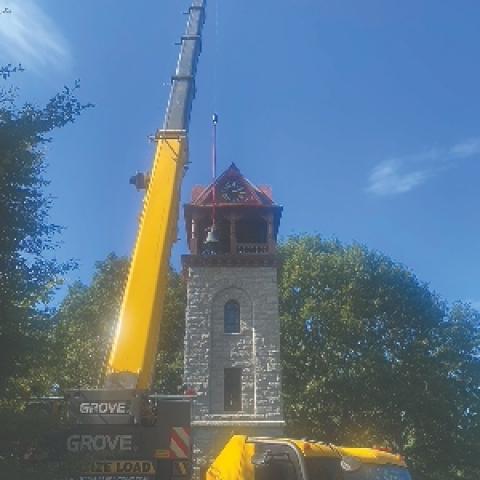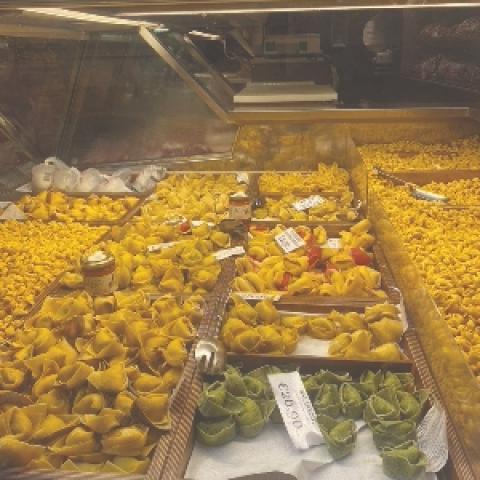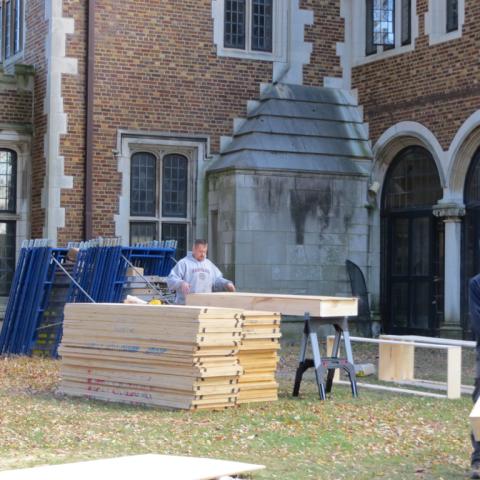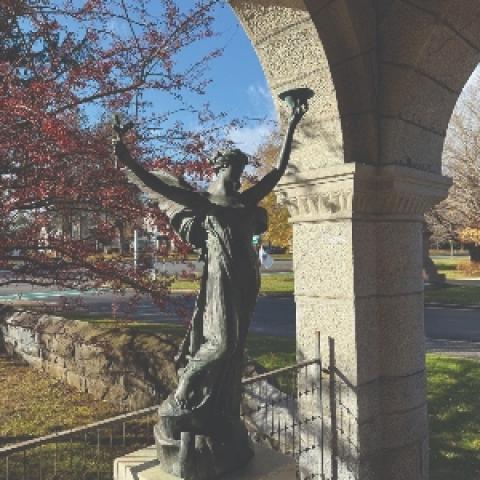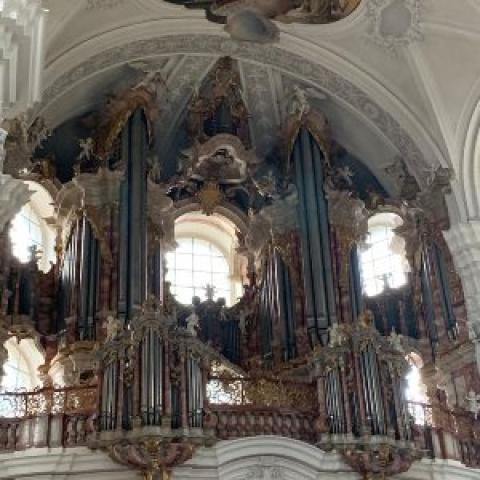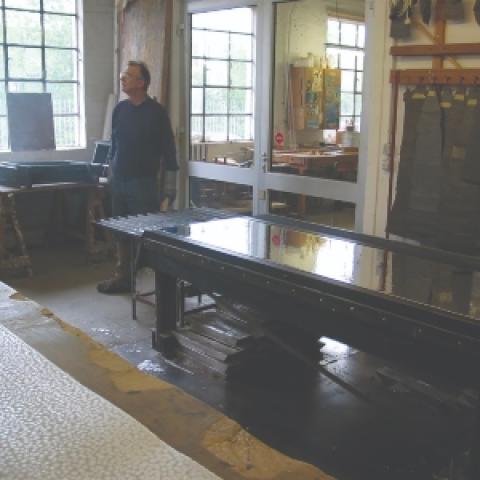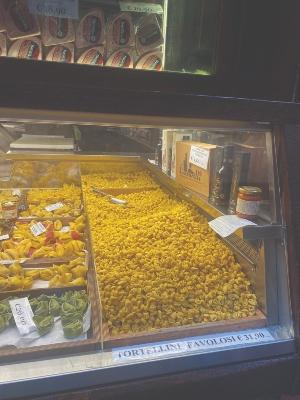
An explosion of creativity
We have learned to tell time according to the pandemic, separating the “before and after” times as many of us have settled into vaccinated life and relaxed our mask-wearing regimens. I did not take to the air until a quick trip to Houston in February, but I had a couple other trips this year before Wendy and I went to Greece and Italy in May. Our daughter lived in Athens for five years, and her husband is Greek, so we have deep connections with family there, and our trip was planned around the “destination christening” of our youngest grandchild. That family of four (there is a five-year-old sister) lives in Brooklyn, but his parents were eager to follow the Greek tradition of christening, which is scaled a lot like a wedding with a big catered party, so off we went.
After the family festival, we flew from Athens to Tuscany, landing in Bologna and taking a train to Florence. It was my first time in Italy, and I was excited to see the Renaissance art I had studied so eagerly in college and to learn whether all I have heard about food in Italy is true. It is. In preparation for the trip, I read Brunelleschi’s Dome by Ross King, a vibrant history of the building of the great Duomo in Florence, the competitions to determine the architect, and the extraordinary feat of the construction of the immense dome, which is still the largest in the world nearly 600 years after its completion.
Construction of the nave of the Cattedrale di Santa Maria del Fiore (Cathedral of Saint Mary of the Flower) was begun in 1296 and completed in 1380, a timespan that included fifty years of slow progress due to lack of funding and a ten-year hiatus because of the Black Death. As the nave was nearing completion, there was no concept of how to build a dome whose base would be 180 feet off the ground and whose diameter would be nearly 150 feet. It seems a little funny to have built such a huge structure without knowing how to complete it, but during the thirteenth and fourteenth centuries, architects were experimenting with the limits of structure, resulting in events like the collapse in 1284 of part of the cathedral at Beauvais in France, which was so tall and had such huge windows that the flying buttresses could not support the structure.
Filippo Brunelleschi (1377–1436), a goldsmith, sculptor, and architect, entered a competition along with goldsmith and sculptor Lorenzo Ghiberti (1378–1455) for the design of the dome. Ghiberti had earlier beaten Brunelleschi in a competition for the design of the huge bronze doors of the baptistry that shares the piazza with the cathedral. You can imagine there was no love lost between those two. Brunelleschi’s plan for the dome would involve no centering scaffold, which had never been done before, and included the invention of equipment that would hoist stones weighing up to two tons to the extreme height of the dome, 375 feet up. The main hoisting crane was powered by oxen walking on a circular treadmill installed in the crossing of the cathedral. Imagine the hay bale and shovel maintenance of that machine!
The Museo dell’Opera del Duomo (Museum of the Works of the Cathedral), just across the narrow street behind the apse of the cathedral, houses Lorenzo Ghiberti’s original bronze baptistry doors, protected from the elements and replaced by brilliant replicas at the baptistry. Each door includes twenty-eight reliefs depicting scenes from the Old Testament; each door is fifteen feet tall and weighs thirty tons. It must have been quite a challenge for fifteenth-century craftsmen to hang those doors on freely swinging hinges. There is also a display of hoisting tackle used during the construction of the dome, much like the gear used on Organ Clearing House job sites.
I recommend King’s Brunelleschi’s Dome, a fascinating read that provides vivid images of life in fourteenth-century Florence and insight into some of the brilliant minds of the Renaissance. King’s descriptions of the roads and spaces around the Duomo evoke the smells of the thirteenth-century city and are a fun prelude to walking on the same streets today. Those streets are defined by 600-year-old buildings and were not designed for modern traffic. Delivery and garbage trucks are in miniature scale, taxis are ubiquitous, and flocks of tourists cling to the edges in single file as the vehicles squeeze by.
Adjacent to the Duomo is the campanile designed and built by Giotto di Bondone (ca. 1267–1337). Many of his paintings grace churches in Florence, particularly in Santa Croce (Holy Cross), which contains a dazzling display of Renaissance art. The campanile, whose construction started in 1334, almost 700 years ago, is almost fifty feet square and nearly 280 feet tall. It houses seven bells, the largest of which is about eighty inches in diameter.
The exterior of the campanile is decorated with dozens of relief panels about eighteen inches across, some diamond-shaped and some hexagonal. The collection depicts the planets (Saturn, Jupiter, Mars, the Sun, Venus, Mercury, and the moon), theological and cardinal virtues, liberal arts (music, geometry, rhetoric, etc.), and the seven sacraments. Human history is depicted, along with the mechanical and creative arts (music, blacksmith, building, medicine, agriculture, etc.). These spectacular pieces were started by Andrea Pisano (1290–1348) in 1347 and completed by his workshop after his death. Like the baptistry doors, the original pieces have been removed to the museum to protect them from the elements and replaced outside on the building with replicas.
§
Thirty-nine years after the death of Brunelleschi, Michelangelo di Lodovico Buonarroti Simoni (1475–1564) was born in Caprese, about seventy-two miles from Florence. I have studied, thought, and written about Michelangelo’s genius and the spectacular art he produced, but finally visiting Florence where so much of his work is preserved was the thrill of a lifetime. David is breathtaking. I had the same feeling when I saw Van Gogh’s Starry Night in the Museum of Modern Art in New York or stood on the rim of the Grand Canyon for the first time. I had heard and read so much about it and seen countless photographs, but nothing prepares you for standing in its presence in real time. Michelangelo captured the entire human condition in that piece of stone. He proved to us that people in the early-sixteenth century were just like us, not counting the last half century of Cheetos and French fries.
Michelangelo created this seventeen-foot-tall statue between 1501 and 1504 at the age of twenty-six. The exhibit hall that David dominates also includes several unfinished sculptures by Michelangelo that offer a glimpse into how a human figure is drawn from a block of stone. The finished David weighs about six tons. The original stone must have weighed at least twice that. Michelangelo started chipping away early in the morning of Friday, September 13, 1501. I suppose he worked through the weekend. It seems a miracle that he was able to pull that figure out of that stone.
So much has been written about this iconic sculpture, the youthful pose, the contemplative but tense facial expression. While many representations of David show him after his defeat of Goliath, Michelangelo’s David is shown just before the battle, after he has determined to fight. Muscles bulge with tension, and the body is slightly twisted as though he is about to spring into action. The surface of the marble shimmers, and the figure seems almost alive. We stood staring, taking a few steps to change the angle, with a sense of awe . . . amid a throng of tourists with phones in their hands. Some looked up from their phones to snap a picture, but most were nose down, immersed in their screens in the presence of one of the most famous pieces of art in the world. It is a triumph of human expression, of one man’s interpretation of a legendary mythical moment in time, his squeezing life, action, and emotion from a huge piece of stone, and most of the people in the room were not present to appreciate it, taking up space while dulling their minds.
Wendy’s car has an annoying feature that nags the driver when taking eyes off the road—look to one side for a few seconds too long, and you hear a loud ding as the dashboard flashes, “Eyes on the road.” I wonder if a museum hall could have such a feature. Take your eyes off the art, and you get ejected.
A lucky stroke during our visit to Florence was to visit the Museo dell’Opera del Duomo just as it opened in the morning. Ghiberti’s bronze doors are among the first things you see as you enter, but deeper into the museum is another masterpiece of Michelangelo, The Deposition, the same scene as his famous Pietà in Rome, Jesus being removed from the Cross. It is smaller in scale than David, the figures are roughly life-sized, but like David across town, it is exquisite. Michelangelo worked on this piece between 1547 and 1555, when he was in his seventies. It is supposed that the figure of Nicodemus standing behind Christ is Michelangelo’s self-portrait. We were lucky because we were alone in the room with The Deposition for over fifteen minutes. I did take some photos, but I did not check email, send a text, or order dog food to be delivered before we got home.
§
The lives of Lorenzo Ghiberti and Filippo Brunelleschi encompass the earliest days of organ building. There are different theories about the age of the organ in the Basilica at Sion, Switzerland, made famous by E. Power Biggs’s recording from the 1960s. His jacket notes claimed it was built in 1390, while scholars and historians have suggested 1435. In any event, that instrument is from the same time as Ghiberti’s doors and Brunelleschi’s dome—all three artworks are tributes to the skill, ingenuity, and creativity of the day. The organ in the Koorkerk van Middelburg, Utrecht, the Netherlands, dates from 1479, and the organ in the Grote Kerk in Oosthuizen was built in 1521.
Andrea Gabrieli (1532–1585) was appointed organist of San Marco in Venice in 1566, two years after Michelangelo’s death. Orlando di Lasso (1532–1594) was born when Michelangelo was fifty-seven. Di Lasso and Gabrieli met in Munich in 1562, exchanging musical ideas that surely advanced the art of music during the Renaissance. Jan Pieterszoon Sweelinck (1562–1621) was born in Deventer in the Netherlands two years before Michelangelo’s death. It is interesting to note that all this dazzling creativity was going on in Europe 200 years before the American Revolution. Sweelinck died the same year that British colonists landed at
Plymouth, Massachusetts.
To the hills
We rented a car in Florence and drove to Camaiore, thirty minutes northeast of Lucca, near the coast of the Ligurian Sea, where we spent four nights in a hilltop villa owned by a wine merchant friend in New York. The house was a lofty eighteenth-century place with thirteen-foot ceilings, marble floors, and feral cats. The bathtub was Carrara marble, as was the three-foot-wide kitchen sink. Our friend directed us to the local butcher, coffee shop, and pasta house. We had lunches in the pasta restaurant and cooked dinners at “home” for the nights we were there using the home-made pasta, treats from the butcher, and produce from a fruit and vegetable shop.
From Camaiore we took day trips to Lucca where we visited Puccini’s birthplace and Carrara to see the quarry that was the source of the stone provided to Michelangelo for the masterpieces we had seen in Florence. We were there on a Sunday, so there was no work going on, but we saw hundreds of heavy trucks lined up at the nearby port loaded with stones marked in the tens of thousands of pounds. It is a dramatic mountain drive to the quarry itself, and we marveled at the skill and determination of fifteenth-century workers who managed to separate those huge blocks of marble from the mountain and transport them eighty-five miles to Florence. We got out of the car at the gated entrance to a quarry yard full of heavy equipment to soak in the view, and I pocketed three plum-sized chunks of marble that now sit on my desk as inspiration.
Mangia
We drove to Bologna, turned in our car, and took to the streets. After finding our hotel, we met a guide we had engaged for a personal food tour of the old city. Books have been written about experiences like that (I know because I’ve read them), but to walk from shop to shop for three hours with that charming woman sharing her passion about the city’s culinary culture was a highpoint of the trip, not to offend Brunelleschi and Michelangelo. Meat preserved and presented in hundreds of ways is everywhere. The care and pride that goes into the whole gamut of raising, processing, presenting, selling, and consuming food is obvious as people with gleaming smiles offered us samples and described their lives. We were taken to a “laboratory” associated with one of the finest pasta shops where a dozen women were making pasta of all descriptions. I was especially enchanted by Consuela who was making tortellini, taking a pinch of the pork filling from a pouch, and twisting little squares of pasta into the classic shape. They offered us a sample, gently boiled with a little Bolognese sauce. I have nothing to add.
Spectacular meals with exquisite wines (we came home with a new appreciation for Sangiovese), lots more art including Michelangelo, and driving rain completed our short stay in Bologna. It is a city of porticoes, long colonnades that line many of the city’s streets, more than twenty-four miles of them. They originated in the Middle Ages, some dating from before 1100, and were developed to increase the interior space of the upper floors of houses, leaving space for pedestrians at ground level. Most of them have vaulted ceilings, many of which are decorated with frescos. However much they increased the square footage of a city apartment, they sure were handy during four days of steady rain. We were feeling a little grumpy about the constant rain until we learned while checking out of our hotel that thirty inches of rain had fallen in just a couple days north of Bologna, terrible flooding was ruining crops and destroying houses, and more than eighty people had died. Desk clerks and taxi drivers were distraught about the regional calamity.
We flew to Zürich from Bologna where we changed planes to fly home to Boston. I was working on my iPad during the first flight and put it in the pocket of the seat in front of me when a meal was served, and got off the airplane without it. We had left the plane on the tarmac and were bused to the terminal, so I knew there was no hope of getting back to the plane, and I started an online claim for the lost article. As we were taking our seats in the next plane, an airport worker in a reflective vest handed me the iPad. They found it while cleaning the plane and traced our seat numbers. Fly Swiss Air.
§
We were enriched by our ten-day immersion in Renaissance art, and I kept thinking about how the history of the organ and its music developed concurrently with the work of Brunelleschi and Michelangelo. Heinrich Scheidemann (1595–1663) was born sixty-three years after Andrea Gabrieli. Dieterich Buxtehude’s lifespan (c. 1637–1707) overlapped with Scheidemann’s by forty-two years, and Johann Sebastian Bach was born forty-eight years after Buxtehude. That succession of great musicians who nourished the art of the organ takes us from the time of Michelangelo to Franz Joseph Haydn (1732–1809).
The Renaissance was an explosion of creativity and inventiveness that covered the fifteenth and sixteenth centuries. Art, architecture, music, and science increased exponentially. I have mentioned some of the giants, but each of the great museums we visited is chock full of the work of dozens of other artists.
We’re living in a time of political mayhem and ecological disasters. Take an afternoon to visit a museum and be reminded about what’s good about human expression, and draw the lines that connect the organ and its history to the wide world of arts and humanities.

